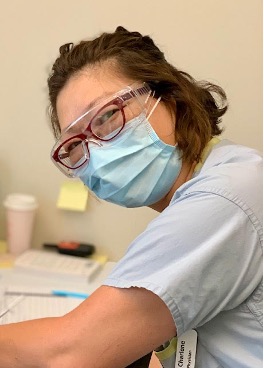Dr Charlene Lui, a family physician at the Burnaby Maternity Clinic, led a project to reduce clinic referral wait-times from up to 90 days to just a few days through an SSC Physician Quality Improvement (PQI) and SSC Facility Engagement (Burnaby Hospital) collaboration.
Dr Lui explains the importance of reducing the wait-times for patients. “There are certain tests that need to be done at particular points in a pregnancy. Waiting up to three months from the time of referral is not optimal. For the patients it can be an anxious time, particularly when they have unaddressed concerns.”
The Burnaby Maternity Clinic is an important piece of Burnaby’s Primary Care Network. Most of Burnaby’s family physicians use it to provide primary maternity care to low-risk patients. The clinic also eases capacity for OB/GYN physicians to focus on high-risk pregnancies – making better use of their time and specialty training.
The clinic currently serves approximately 9000 patient visits per year, so making changes to the referral process was a major undertaking.
“I initially was reluctant to take this on as a PQI project because it felt very complex and therefore, I was worried it would be very difficult to make a significant impact,” says Dr Lui. “However, my PQI coaches and colleagues encouraged me to tackle something hard. Failure was an option because I would learn the most about how to do quality improvement. There’s a great freedom in being told ‘it’s ok to fail’.”
Physician Quality Improvement (PQI) and Facility Engagement are initiatives of the Specialist Services Committee. PQI provides physicians with training and hands-on experience in quality improvement with the aim of creating a culture of learning to continuously improve BC’s health care system.
Facility Engagement provides funding for medical staff working to collaborate with other physicians and their health authority to improve patient care and their workplace.
There were a lot of moving parts to this project that made it a difficult task. The clinic aims to be open and flexible to the community’s needs. Referrals to the clinic come in a variety of ways - from a physician, a walk-in clinic, social workers, community agencies or from patients themselves. Dr Lui notes that because of how referrals are received, the biggest challenge was determining how to process them in a timely and efficient way.
With engagement funding, Dr Lui met with physicians on the maternity clinic team, the staff, and the Fraser Health clinic manager to get on the same page about priorities, and why it was so important to make changes. Team meetings were held with interested parties and each step was tested. The feedback led to adjustments as the work progressed. “Getting the whole team involved was really important, ” says Dr Lui.
Dr Lui developed a detailed process map on how the clinic was functioning. “This was key to creating a shared understanding of everyone’s role, each other's priorities and where improvements could be made.”
It became clear that the biggest bottleneck was tracking each new referral and ensuring an electronic chart was produced in a timely manner, and the use of a referral tracker document was instrumental in producing change. A cultural shift on clinic priorities, a clearer definition of roles and responsibilities, and an educational component resulted in an orientation package for staff to ensure everyone follows the same steps when processing referrals.
However, the first priority was to reduce the current wait list. This was accomplished through a team effort of MOAs, and physicians.
“While we were transitioning to a shorter wait-list, I asked our physicians to look at the urgent list and personally call patients when they had time,” says Dr. Lui. “The physicians’ willingness to initiate a virtual first contact with patients was really instrumental in getting us caught up. It also served another purpose by allowing the physicians to confirm that needed tests were ordered before a patient came for an in-person visit.”
Dr Lui also credits the support she received from the PQI staff in helping her stay on track and providing needed resources. Janice Eng, PQI Project Leader worked with Dr Lui and says, “Charlene was fabulous, very open-minded. She would take ideas and never shy away from difficult tasks.”
Challenges included staff retention. With the high volume of patients, staff were burning out. At one point, Dr Lui paused the project when the MOA left, with no continuity of staffing to continue the improvement work. However, about a month later, physicians requested the work start it up again as processes began to revert backwards, leading to increased wait-times and inefficient work flows.
Within two months of restarting the project, Dr Lui’s aim of reducing wait-times to one or two days was achieved.
Dr Lui observes, “while the outcome of improving access was huge, it was really about delivering the best care, while taking into account the needs of the patients, the physicians, the managers and staff.
“It was about building communication pathways and creating a shared culture of ‘we are in this together’ – that is what makes me proud.”
This project was supported by SSC Physician Quality Improvement, the Burnaby Hospital Medical Staff Physician Society, SSC Facility Engagement.

Dr Charlene Lui



